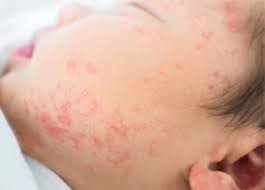Mucus blossom is a common type of rash for all your
children. Mucosal rash in infants happens when teeth come in. This type of rash
is harmless and parents do not have to worry much if the child is affected by
this rash.
For a baby, drool blossoms may be uncomfortable. But,
caregivers are there to help them get out of drool flowering following some
simple remedies at home.
In this article, I'm going to give you a detailed account of
Drol and other types of rash that happen to children, especially. What are the
reasons, when to contact a doctor, what could be the possible treatment? And in
the end, a FAQ section quenches your thirst for drooling. However, we will
start rolling together.
Drool Rash
Like I said before, because of erosion, children are affected
by drool blossoms. But few cases exist even when babies face the problem of
drool's rash, even if they don't get new teeth.
When your child is affected by drool flowering, you may find
a persistent presence of saliva in the various areas of his chin, neck or even
chest area. This saliva can turn red. During this type of situation, all you
have to do is take care of the current drool bloom and prevent a new one from
coming out.
Mucosal rash will begin to come out in the area of the
baby's cheeks and mouth in the initial phase. Then it will spread to the fold
of the neck.
Remover blossom looks like a flat red patch at the hem that
comes with tiny red bumps. Sometimes they also show a cracked presence. Mucus
will spread if your child uses a pacifier that moistens the skin around the
child's mouth or if your child keeps the food in his mouth over time.
Mucosal rashes will give your child a hard time and will
surely provoke his delicate skin if you do not take the necessary steps to
prevent it.
Reason Behind Drool
Rash
Saliva is usually enriched in digestive juices, and these
digestive juices always remain on the child's skin. When the child rubs his
skin with pillows, sheets, toys, clothes and many other things because of the
irritation, then the perfusion blossom spreads all over the child's skin.
In the initial stage, although this rash is harmless, if you
do not treat this rash, it will spread to your child's skin. And it will become
another state called "Impigigo." This condition is known as infectious
bacterial infection.
However, let’s find out the
possible reasons for drool rash from below
Pacifier: When
your baby sucks his pacifier, saliva comes out of his drip, which separates the
mucus in that area. If the pacifier locks the saliva in place, your children
will be affected by the mucosal rash soon because no air can dry out this area.
Teething: The
first and foremost reason for drooling is teething. While teething, children
are constantly teasing their hands or the carpet. As a result, saliva exits
from the inside of their mouths that trickle down the sides of their faces,
into the folded area of their necks, and even it goes down the chest area.
Baby Food: After
eating, if smoked food stays on your baby for a longer period of time, this
will allow Rile to spread around your child's mouth. To get rid of it, keep a
cloth nearby to erase any leftover food.
How
to Prevent Drool Rash Toddler?
In general, prevention is always better than cure - this is
a common myth. If your baby is affected by mucus, the problem is likely to
increase if not properly identified and not treated. So, if you want to prevent
rash of your child's mucus, you can take the next prevention without delay.
Whenever your baby
cloth gets wet, replace it as soon as possible. A damp or wet cloth will cause
your child to be affected by drooling.
Keep muslin cloths
supplied as much as possible. Keep them within your reach and every time you go
on a trip, keep them in your bag. Replace your baby cloth while drooling.
After every feed,
don't forget to thoroughly clean your child's mouth and fold your neck.
Look for absorbent
bibs and purchase them. The absorption apron will keep the fabric and chin from
getting wet. This will greatly help you to keep your baby from drooling.
During sleep, using preventative cream will be a
possibility. Therefore, the mucus will not come into contact with your baby's
skin.
At the dental stage, do not force your child to eat hard
food. They may not be able to eat hard food because of gum inflammation. Try to
cook different recipes for them, which are also full of nutrition.
When the baby is rubbed and rubbed on the facial area, the
condition can get worse. To keep the condition under control, soak the area,
wet it properly, and then put a washcloth under the sheet. Absorbing bib will
also help keep your baby from drooling. You need to be attentive to your baby's
prescription to prevent drooling.
Except for the suggestions above, you can also follow the
options below as part of prevention



0 Comments